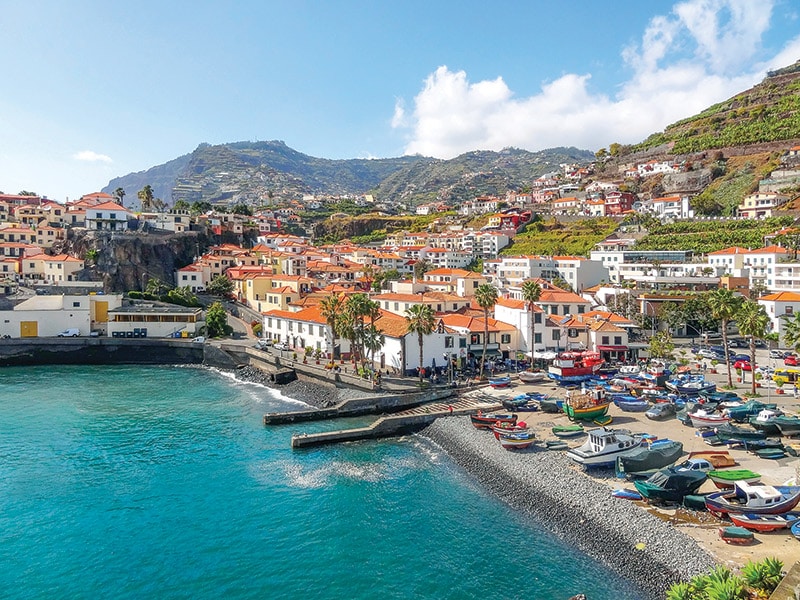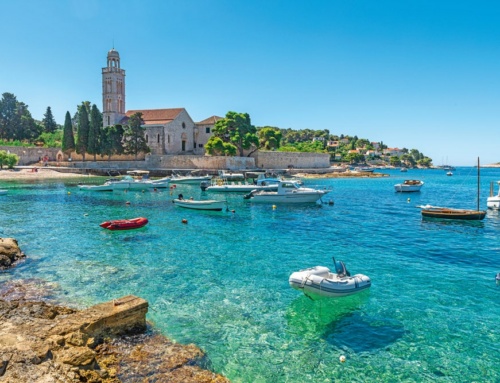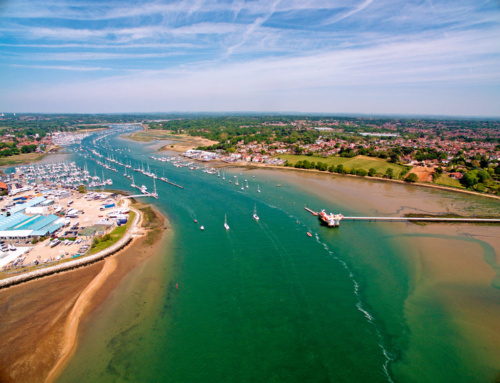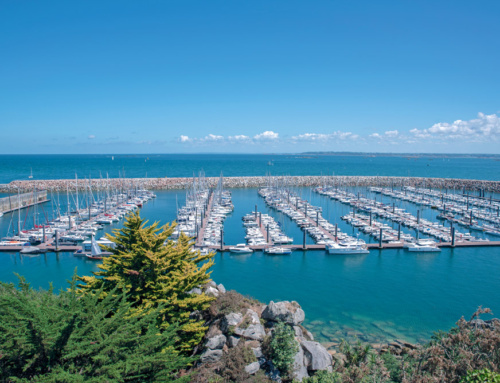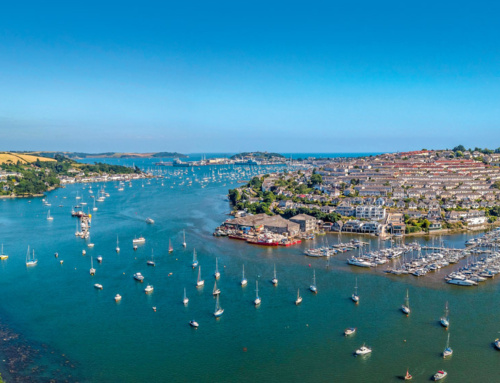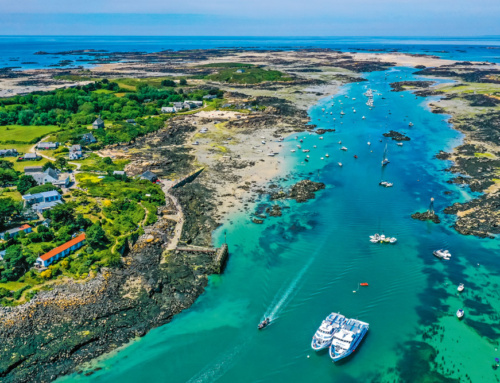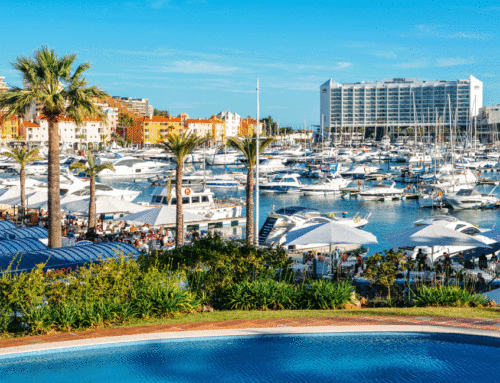- Flying into Madeira is an experience in itself.
- With some of the highest sea cliffs in Europe, Madeira has made good use of these features with a fabulous feat of engineering.
- Once you have seen and experienced the island you will understand why it has become such a popular retirement and holiday destination.
Simon Everett travels to the beautiful Atlantic island of Madeira, which offers a fascinating mix of geological wonders and one of the most spectacular and abundant marine wildlife habitats on the planet. A sports fisherman’s idyll, as we are to discover …
Many of us dream of retiring to some sunny spot with a boat and a view of the sea. For Howard and Ann Williams, this dream has become a reality. The paradise they have chosen, lying between the Canary Islands and Morocco, is an autonomous region of Portugal and comprises a small archipelago of four islands. The main island of Madeira has long been a tourist haven, and is now becoming a popular retirement destination due to the subtropical climate, lack of crime and slow pace of life.
The main island is the top of an ancient volcano sticking in proud and dynamic style out of the depths of the mighty Atlantic Ocean. Madeira was a geological hot spot, formed over many volcanic activities, which is why there is no actual visible crater to speak of. Madeira itself covers only the top 25 per cent of the volcanic mountain, rising up from the ocean floor, over 3000m deep just a mile offshore, to a height of 1860 metres at Pico Ruivo, the highest peak on Madeira. This sudden rise out of the ocean makes Madeira a huge reef that attracts pelagic game fish, and the big-game fishing on offer in turn attracts big-game fishermen from all over the world. Madeira is one of the hot spots for big blue marlin, with more than its fair share of 1000lb-plus fish captured each year, and the largest average size of fish anywhere in the world. Later in the season, there are also yellowfin tuna and other sport fish to keep anglers entertained and barbecues supplied.
Howard and Ann Williams are avid anglers and have spent their lives travelling for big-game fishing around the world, including many trips to Madeira over the last 30-odd years. It was their dream to retire there and run a big-game charter boat, so they started searching for a house on the western side. They had studied the weather patterns and fishing over the years, and the west has better weather and is quieter. Due to the north-westerly trade winds, the western coast has a much better climate than the weather shores on the opposite side of the island, and their decision to settle on the western shore was largely based around this fact. They get less rain and the wind is generally favourable.
They decided to set up home in Calheta, where there is a sheltered marina that gives immediate access to the fishing grounds, within a hundred metres of the harbour entrance, and makes a great base to explore this more sheltered side of the island where there are several points of interest to see and the sea life is plentiful. Of course, to partake in this salad of seaborne activity, they needed a suitable boat. Howard was set on getting a high-quality boat for the job and he searched the brokerages in America, flying over to see several boats, until he found a Luhrs 36 that was custom-built with a higher standard of accommodation than normal. The engine room houses a pair of Yanmar 315hp turbo diesels on conventional shafts with four-bladed props. Long-range fuel tanks were already fitted, and the boat was already rigged with a top-quality fighting chair and outriggers, and the flybridge was nicely appointed. It was just the boat they had been looking for.
They bought the Luhrs and shipped her back to South Wales in order to prepare Sorted for the voyage out to Madeira. They planned the passage in four legs, from their home berth in Neyland Marina at Milford Haven to Camaret in Brittany, where they stopped for fuel and gained useful knowledge about the true fuel consumption. Howard calculated that they had a 1000nm range at the boat’s hull speed of 7.5 knots. From Camaret they stopped again in Laucruna just to take on water and some victuals, and to top up the fuel. From Laucruna they made Porto Sinel , where they did the same and readied themselves for the 540nm open-water passage to Calheta.
On the way they trolled a couple of lures and caught a brace of small tuna, which was just as well because the generator packed up at sea, which meant they had lost the microwave. Howard filleted the fish and packed it in foil with chopped onions and some seasoning, and then put it on the turbo header for an hour. When they took it out of the foil wrap it was cooked to perfection, so Howard made a note of the recipe and called it ‘turbo tuna’! The entire passage took seven and a half days and they covered a total of 1585nm. The boat proved her seaworthiness on the trip and gave Howard a chance to really gel with her and to get some meaningful fuel figures for future passage making.
Even though the marlin fishing off Madeira is some of the very best in the world, Howard spotted a niche in the market that was virtually untapped and is one that places less pressure on the skipper and crew than big-game fishing, although that is where his love lies. The Luhrs has a resonance in the water that seems to raise fish to his boat. For the last couple of seasons they have had significantly more fish to their boat than the other charters, and even though the others are fishing in a similar fashion and covering the same water, Sorted has caught more fish and Howard has put it down to the sound or wake signature of his boat.
Madeira is a tourist haven and the volcanic coastline is full of fascinating features and history. For instance, the longest-standing peace treaty still in force is the Treaty of Windsor. The roots of the Aliança Luso-Britânica, or Anglo-Portuguese Alliance, can be traced back to 1294 and the alliance was renewed in 1373, then further sealed between King Richard II of England and King John of Portugal on 9th May 1386 with a pact of perpetual friendship between the two countries.
With one million tourists visiting Madeira each year, there is an unfulfilled demand for sightseeing and wildlife cruises, or simply catering cruises. The waters are visited by over 20 different species of dolphins and whales, with the best period being the later summer months. There are even blue whales – the largest creatures alive on the planet – to be seen on occasions. Dolphins are seen virtually every day and minke whales are common along with pilot whales. The upwelling oceanic currents ensure rich feeding, which in turn draws the predators, both in the air and in the water, and wildlife tourism is a growing trend.
As a volcanic island, Madeira has geological features created by the action of the lava and the sea, such as the natural sea swimming pools at Porto Moniz on the north coast. Here the harbour is sheltered by a long breakwater wall but is open to swell from the east, and it is home to one of the inshore lifeboats. The swimming pools are flushed with the tide and the swells that crash into them through gaps in the jagged rocks. Crossing a short bridge to the restaurant provides the chance to eat while taking in the panoramic views of the pools and the sea beyond. Porto Moniz can be accessed by boat − there is plenty of mooring space along the harbour wall − or by car, down a dramatic, steep cliff road with a series of very tight hairpin bends that give a magnificent view over the sea and coastline.
One of the trips that Howard likes to take is along the coast from their base at Calheta to the most westerly point of Madeira at Ponta do Pargo, which means Seabream Point, ‘pargo’ being a generic Portuguese word for snapper or bream, one of the important, staple food fish that are found in prolific numbers off the point. The dramatic 600ft cliff is topped by a red and white lighthouse that was first lit in 1922 and didn’t become electrified until 1989. From the cliff top the view is amazing and you can actually see the curvature of the earth on the horizon! By boat the cliff is imposing and no less dramatic.
On the same stretch of coast, between Ponta do Pargo and Calheta, lies the most important fishing village on Madeira, Paul do Mar, with its magnificent waterfall that tumbles over the cliff into the small harbour. Such is the location of the village that it was only accessible by boat until a road was opened in 1970. It has become famous in gastronomic circles for the quality of the fish landed here, and several good restaurants serve excellent, locally sourced seafood. Decorating the beach is an unusual statue of a naked man, about 15ft tall, standing on a rock plinth facing the sea, in homage to the sailors from Madeira. Paul do Mar is a must when you visit Madeira.
With some of the highest sea cliffs in Europe, Madeira has made good use of these features with a fabulous feat of engineering. If you have a head for heights, the Cabo Girão glass observation deck mounted on struts about 1800ft above the sea at Camara de Lobos is quite stupendous. Although it is popular with coach trips, if you time it right it isn’t crowded at all, and there is good parking right beside the cafe and shop. Some days the cloud base shrouds the viewing platform, so pick a good day when the clouds are up on the mountain. It isn’t for anyone who suffers from vertigo!
Flying into Madeira is an experience in itself. Like Gibraltar, the approach requires skilled pilots as the crosswinds cause the plane to buck and lurch right beside the cliff wall and houses! Sometimes it might take several attempts to get the plane down, but the pilots are experienced on this route and it is well worth the effort. Once you have seen and experienced the island you will understand why it has become such a popular retirement and holiday destination. Add it to your bucket list. We flew from East Midlands, and as it is only a two-and-a-half-hour flight from the UK it is also close enough for a short break to catch some winter sunshine. Howard will be waiting for your call to book a trip on his boat.
Climate
Lying in the Atlantic 150 miles off the coast of Morocco, Madeira benefits from sunshine most of the year. October to March is when the main rainfall occurs, with about 3in per month; from April through to September light rainfall occurs and nearly all on the mountains. Throughout the year you can expect five hours or more of sunshine per day on average, giving an average winter temperature of around 20°C; through the summer months this rises to 26°C in August and September. The heat is tempered by the tradewind from the north-east, which is reliable for the most part of the year, making the north side of the island windier and wetter than the south. The spring sees the island bloom with wild agapanthus, also known as the Lily of the Nile, growing in profusion along the sides of the road. The national flower is the impressive Strelitzia reginae Aiton, or bird of paradise plant.
Sea mammals
- Madeira is strategically located for watching cetaceans pass by on their migratory routes.
- Sperm whales are present all year round, diving to great depths hunting for squid; the main time to see them is from March to September.
- Short-finned pilot whale – present all year but mainly November to April.
- Fin whale, March–October.
- Sei whale, May–September.
- Common minke whale, June–August.
- Cuvier’s beaked whale, May–July.
- Bryde’s whale, April−October.
- Common bottlenose dolphin present all year, in greater numbers March–October.
- Short-beaked common dolphin, December–May.
- Atlantic spotted dolphin, all year, mostly March–November.
- Risso’s dolphin, June–October.
- Striped dolphin, February–May and again July–September.
- Rough-toothed dolphin, July–September.
Hiring a car
This is where Madeira lets itself down somewhat. The hire car companies at the airport should have triangular fins strapped to their backs: the prices they charge are pretty extortionate. Madeira has massive taxes on importing cars, consequently they are very expensive to buy, own or hire. However, you can circumvent the airport monopoly by arranging car hire from Spanish firm DoYouSpain.com – the total fee will be about 60% of hiring in Madeira. It is also wise to take out their damage waiver and ignore the fear-mongering perpetrated by the airport hire company staff, whose job it is to try and get you to take out extra insurance that you already have. Most hire cars are very small for a good reason. A big car on the tight, twisty roads and when parking in towns is a liability. Take that into consideration when selecting your grade.
Some geography and interesting facts
Madeira was discovered for Portugal by Tristão Vaz and João Gonçalves Zarco, sea captains under the orders of Henry the Navigator, in 1419. It comprises a small archipelago of four islands lying about 340 miles west of Casablanca and is under autonomous Portuguese control. The main island of Madeira is volcanic, green, rugged and with steep slopes that are terraced for cultivation, irrigated by a clever but complex system of channels called lavadas. Madeira is 35 miles long and just 13 miles wide, so about the same size as the Isle of Man. The terraced strip fields and lavadas were built by convicts sent to Madeira to cultivate it for Portugal as a rich land for the production of wheat and, later, sugar cane and the luxurious wine that the island gave its name to.
Fishing types and seasons
Big-game fishing is what Madeira is known for in angling circles as it is the capital of the world for 1000lb blue marlin (‘granders’). In addition to Atlantic blue marlin, there are white marlin in numbers, and towards the end of the summer bigeye and bluefin tuna are regular captures. For those prepared to change their tactics from big-game fishing, there are large amberjack and sharks as well as excellent bottom fishing for snapper species. Calheta is an ideal base on the more sheltered side of the island. This is where Sorted is based.
GAVITO
Big Game Fishing aboard the vessel, Gavito, in Madeira with English skipper, Graham Venters. Graham has over 60 years’ experience in all and 10 years fishing Madeiran waters out of Calheta Marina on the SW coast where the fishing is reputed to be superb. A full day costs £835.00 for up to 4 anglers including lunch and drinks on board. Also offered; all-inclusive weekender, flying in on Friday, fishing Saturday & Sunday and return Monday. Priced from £1800.00 for 4 anglers (excluding flights). Contact Graham Venters on gavitofishing@outlookcom or through www.fishingbooker.com
SORTED is a Luhrs 32 Express built in St. Augustine, Florida with a flared bow and wide beam for great stability and comfort in a seaway. Powered by twin 315hp Yanmars she cruises at a very economical hull speed of 8 knots but can spank up to 36 knots when asked. The standard of her accommodation and the custom wheelhouse layout provide a luxurious experience afloat, while the flybridge gives a commanding view of the sea all around.

